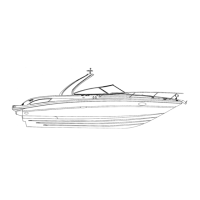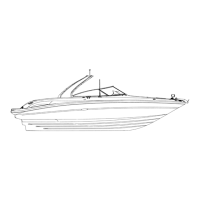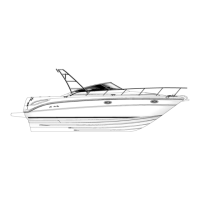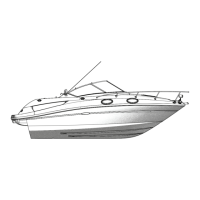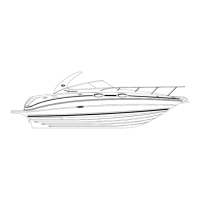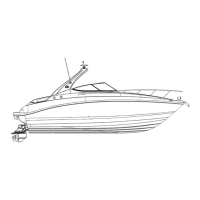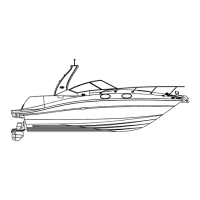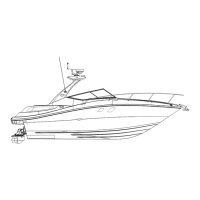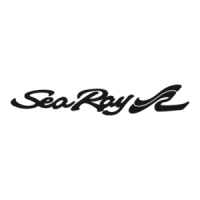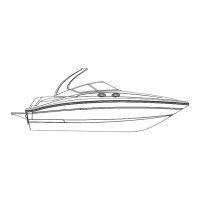Do you have a question about the Sea Ray 290 Sundancer and is the answer not in the manual?
Details the contents of the Owner's Manual Packet.
Contains information from component manufacturers.
Explains the purpose and content of the owner's manual.
Outlines operator duties for safety and boat handling.
Lists organizations and resources for boating courses and safety.
Details what the dealer provides during boat delivery and orientation.
Explains the different warranties accompanying your boat purchase.
Provides a summary of the Sea Ray Limited Warranty terms and exclusions.
Identifies the HIN as the boat's primary identifier and its importance.
Sea Ray's compliance with Federal Boat Safety Act and industry standards.
Guides on obtaining service, parts, and handling repair issues.
Explains the purpose and location of safety labels on the boat.
Details essential safety equipment required by the U.S. Coast Guard.
Describes the automatic fire extinguisher system and its use.
Warns about CO dangers and provides prevention measures and symptoms.
Covers the types of PFDs, requirements, and proper use for safety.
Lists recommended items beyond legal requirements for enhanced safety.
Highlights the dangers of operating a boat under the influence of substances.
Explains how to safely load the boat and manage passengers.
Advises on engine and accessory modifications and their impact.
Covers propeller selection, maintenance, and safety precautions.
Discusses factors affecting boat stability and safe loading practices.
Emphasizes operator awareness and maintaining control in various conditions.
Details weather categories and rules for safe operation in different conditions.
Stresses the importance of navigation, charts, and hazard awareness.
Provides safety instructions for swimming, skiing, and diving.
Outlines procedures for medical emergencies, water rescue, and fire.
Lists important contact numbers for boating safety information.
Mentions compliance with international standards and certifications.
Covers fuel/oil spillage, waste disposal, noise, and wake management.
Provides definitions for common boating terminology.
Explains the meaning of symbols used on controls and in diagrams.
Illustrates the location of various warning labels on the boat.
Covers safe practices for docking, lifting, and storing the boat.
Details where passengers should be positioned for safety during operation.
Explains the stern drive propulsion system and refers to engine manual.
Provides key dimensions and clearance information for the boat.
Illustrates the arrangement of equipment and features on the boat's deck.
Shows the arrangement of interior spaces and amenities within the cabin.
Details the layout of the helm, including gauges and control switches.
Identifies and explains the purpose of various through-hull openings.
Explains the operation of key boat controls like throttle and trim.
Describes the function of essential gauges like SmartCraft, tachometer, and compass.
Covers the use and importance of navigation and anchor lights.
Provides a comprehensive checklist for using the boat.
Details safe procedures for fueling the boat, including static electricity prevention.
Covers safe practices for boarding the boat and managing gear.
Emphasizes the importance of PFDs and their proper use for all passengers.
Instructs passengers on safety, seating, and holding on during boat movement.
Guides on pre-start checks and safe engine starting procedures.
Explains how to shift gears and maneuver the boat safely.
Details the correct procedure for shutting down the engine.
Covers the steering system, its inspection, and potential issues.
Provides instructions for safely starting the boat's generator.
Explains how to connect and use shore power safely.
Details the correct procedure for disconnecting from shore power.
Describes the bilge, pump, blower, and their maintenance requirements.
Covers essential maintenance for the engine and stern drive system.
Guides on choosing, installing, and maintaining propellers.
Explains propeller details, cavitation, and ventilation.
Covers the function, inspection, and cleaning of seacocks and strainers.
Illustrates the layout of components within the boat's bilge area.
Describes the fuel system components and the electric fuel valve.
Details the diesel fuel system and procedures for fuel filter maintenance.
Covers essential safety measures during fueling, including static discharge risks.
Explains the 12V DC system, battery types, and maintenance.
Highlights the need for ignition-protected components in the engine compartment.
Details the electronics fuse block, fuse types, and replacement guidelines.
Describes the EIMs that control boat accessories via illuminated switch pads.
Shows the location and function of the main DC breaker panel and battery switch.
Explains the use of the 12V accessory outlets for powering devices.
Covers the boat's various interior and exterior lighting fixtures.
Details the AC system, shore power connections, and safety precautions.
Provides step-by-step instructions for connecting and disconnecting shore power.
Guides on starting, stopping, and servicing the optional boat generator.
Explains the automatic battery charging unit and its operational modes.
Describes the function and safety aspects of GFI receptacles.
Explains how to prevent electrolytic corrosion using zinc anodes.
Details the Mercathode system for protecting underwater metals.
References electrical schematics for technical reference and service.
Helps locate and understand key equipment and components on the boat.
Explains the function, testing, and safety of the CO monitor.
Details the operation, maintenance, and cooling of the HVAC system.
Covers filling, sanitizing, and maintaining the boat's fresh water system.
Describes the shower sump pump operation and maintenance.
Explains the use of the transom shower and dockside water connection.
Details the gray water system designed for areas with discharge restrictions.
Covers the VacuFlush head, holding tank, and vent filter operation.
Explains the macerator pump for discharging holding tank contents.
Describes the automatic fire suppression system and its activation procedures.
Covers stereo, salon entertainment center, and other audio-visual options.
Details the refrigerator's protection and basic operating guidelines.
Provides tips for canvas installation, cleaning, and safety warnings.
Explains how to operate the horn and its circuit protection.
Guides on operating the optional boat spotlight.
Describes the optional underwater lighting system.
Provides a comprehensive chart of inspection and maintenance intervals.
Space to record important service and boat identification details.
Detailed procedures for inspecting bilge, engine, and fuel systems.
Guides on preparing the boat for storage, including battery and engine winterization.
Steps for preparing the boat for use after a period of storage.
Advice on securing the boat and its equipment when unattended.
Instructions for lubricating seacocks to ensure proper operation.
Checklists for boarding, preparing to depart, underway, and returning.
Advises on selecting safe cleaning agents and avoiding hazardous materials.
Provides guidelines for washing, waxing, and maintaining gelcoat surfaces.
Offers methods for cleaning stains and minor scratches on gelcoat and paint.
Instructions for cleaning and maintaining the boat's bottom paint.
Methods to prevent marine growth on boats kept in the water.
Guidance on cleaning and protecting stainless steel and alloy fittings.
How to clean salt crystals from instrument bezels and covers.
Simple cleaning instructions for gauge and switch panels.
Proper methods for cleaning acrylic surfaces without damage.
Instructions for cleaning, storing, and maintaining canvas and vinyl.
Guidelines for cleaning and maintaining exterior fabric upholstery.
Refers to manufacturer's information for cleaning interior upholstery.
| Holding Tank | 28 gal |
|---|---|
| Sleeping Capacity | 4 |
| Beam | 9' 6" |
| Max Horsepower | 380 hp |
| Fuel Capacity | 125 gal |
| Deadrise | 21 degrees |
